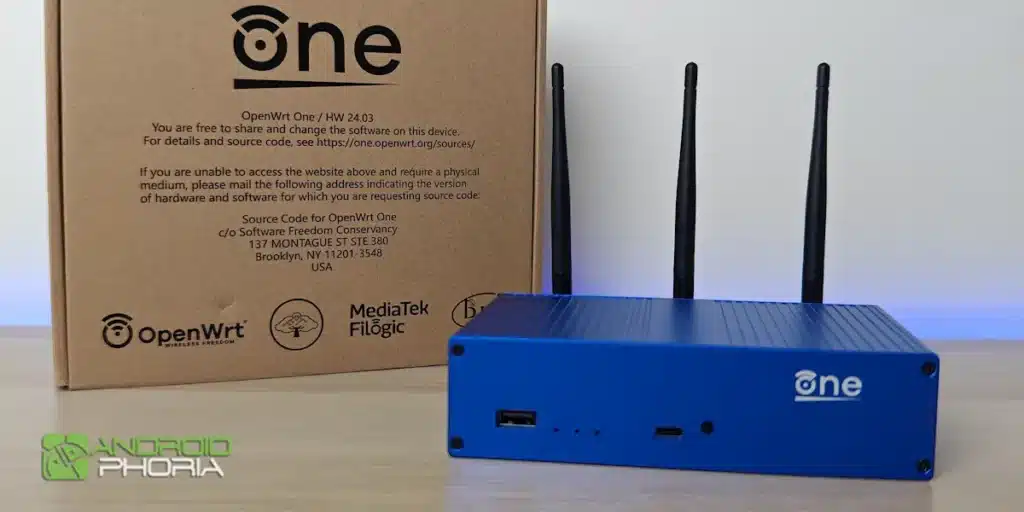
Conventional operator routers usually come with restricted functions. If you are looking for one to give you Absolute control over your connection and reinforced securityThe new Openwrt One is presented as a powerful and interesting alternative. This router includes Pre -installed OpenWRTeliminating the need for complicated flashing processes and offering a more accessible experience, without sacrificing the power and customization that characterize this firmware.
The Openwrt One It is the first official router released by the Openwrt community In collaboration with that of Banana Pi, both dedicated to open source projects. It is an attractive option, not only for users with some knowledge in the field, but also for those who wish to have all the Openwrt advantages Without complications. Accompany us to analyze it!
OpenWRT One: Openwrt’s first official router is 100% free and very complete

Although their specifications and technical virtues can scare the most newbies, Openwrt One is not so difficult to use as it seems. It is a router designed for enthusiasts and professionals, but without forgetting the average user who just begins in the world of Openwrt. Let’s look at your technical file before examining it in depth:
|
Character |
Openwrt one |
|---|---|
| Dimensions and weight | 148 x 100.5 x 31 mm. 214 grams. |
| Technology | Wifi 6 of double band. |
| Processor | MEDATEK MT7981B 1300 MHZ WHAN: Medium Mt7 hardware: |
| Storage | 256 MB A set and 16 MB nor (for recovery). |
| RAM | 1 GB DDR4. |
| Ports | 1x Ethernet 1 GBIT LAN 1X Ethernet 2.5 GBIT WAN (POE) 1x USB 2.0 2x USB-C |
| Antennas | 3 MMCX, removable. |
| Extras | SLOT M.2 SSD 2230/2242 and mikrobus slot for expansion modules. |
| Firmware | Openwrt. |
Leave elegance aside to focus on durability
Unlike most routers that use a thin and compact plastic body to prioritize elegance, the OpenWRT One puts aesthetics in the background and bets on a Large and robust housing made of aluminum alloy To better endure time attacks.
It has a rectangular box form of 15 x 10 x 3.1 cm with Four visible screws on the front and rear parts so you can easily uncover its housing and make the hardware changes you want easily. On the sides it has ventilation grilles to dissipate heat and, together with its aluminum construction, avoid overheating. Chips inside are cooled with a large passive dissipator that does not generate noise.
In the OpenWRT One box comes a 30 W charger with its respective USB-C cable for food. I also know They include three Wi -Fi antennas, which connect to the three MMCX connectors located in the rear of the router. In addition, four rubber legs come to put them down the router and thus give more stability. As if that were not enough, it brings a screwdriver and some screws to mount and disassemble its housing.
Versatile ports and double storage for greater reliability
As for the ports, in the back It has two Ethernet: one 2.5 GB WAN and another 1 GB LAN. It should be clarified that the Ethernet Wan is Poe, so it can receive both the internet and the food for this port with a single cable. If you do not have a Switch or Poe injector, there is no problem, because right next to the Wan port there is a USB-C port for food.
By the way, the assignment of LAN and WAN ports in the Openwrt One is configurable. With a couple of clicks, you can Make the 1 GB Ethernet port be WAN and the 2.5 GB poe portThe vice versa. It’s your decision! Of course, I miss at least a couple of additional Ethernet ports. Just having two forces to buy a network switch if you want to connect more than one cable device.
Back, it also has a RESET button and a NAND/NOR to physically change between the two types of storage that the router uses to house its firmware. The 256 MB NAND memory is the main one, while the 16 MB NOR is an emergency memory to recover the router in case of a fatal error. This double storage design improves system stability and minimizes Bricko’s risk during firmware updates.
On the front, it offers a USB 2.0 port to connect a storage unit (ideal to configure a basic NAS), as well as A USB-C port that provides access to the series console for the administration, diagnosis and advanced recovery of the router. Right there, it also has three LED indicators and a multipurpose USR button.
Hardware at the height of expectations
From the official OpenWRT router we cannot expect exceptional hardware with various customization options. And they have fulfilled! The OpenWRT One is driven by a powerful processor MEDATEK MT7981B (Filogic 820), with two nús Cortex-A53 to 1.3 GHzaccompanied by 1 GB of RAM DDR4 and 128 MB of Flash Spi Nand storage for the system.
Your wifi chip is the MEDATEK MT7976C offered Wi -Fi 6 of 2.4 GHz and 5 GHz. All this combination guarantees agile and efficient performance, ideal for managing advanced configurations without sacrificing stability.
It also has an Mikrobus expansion module and a real -time clock (RTC) fed by a CR1220 button battery. But what surprised me most is that It has a m. It is quite useful because it allows to transform the router into a small multifunction server, taking advantage of the speed of the SSD for tasks that require rapid and persistent storage, such as sharing files, download content or Execute additional services directly in your network heart.
The basic OpenWRT One configuration process is relatively simple. It starts connecting the network cables to the respective ports and lighting the device. Then, You have to access the configuration interface by entering the 192,168.1.1 direction from a web browserWhere you can change to the PPPOE mode, activate the Wi -Fi and configure the plugins sources and then download the ones you want.
Then, you can Update the firmware through the Luci interface or through a USB unit. It should be noted that this OpenWRT interface is quite intuitive and is not very complicated to use, but for the general public it will require some learning. The good thing is that there are thousands of tutorials on the Internet that will help you, including the Official Openwrt documentation in Spanish.
The OpenWRT One does not focus on performance, but in functionality. While his Maximum speeds of 574 Mbps in 2.4 GHz, 1201 Mbps in 5 GHz and 2.5 Gbps by cable They are more than enough for any type of use today, it really does not impress in this aspect compared to WiFi 7. more freedom and more functions.
With Openwrt, a range of possibilities that do not offer conventional routers are opened. I could make an article dedicated to everything that is capable of making a router with this firmware, but to summarize it, here I leave you Some basic things that I could do with the Openwrt One:
- Multiple Wifi networks: Create independent networks for different uses. For example, a private network for personal devices, a network for work isolated from the rest, a network for IoT (smart devices) with restricted access, a network for children with content and schedules filters, and a network for guests without access to your local network.
- VLAN: Segment your network similar to Wi -Fi, but for wired connections.
- Red level advertisement blocker: Eliminate advertising on all connected devices.
- Integrated VPN (like Tailscale): Access your local network safely from anywhere, without opening ports.
- Schedule control: Limit Internet access at certain times.
- Bandwidth limits: Prioritize traffic and prevent a device from saturating the network.
- Automatic reset: Program reset if detects connection failures.
- Coverage extension: Activate a mesh network with other OpenWRT routers to expand the WiFi signal in Casas Grandes or several plants without losing performance.
- File or multimedia server: Connect a router storage unit and configure samba (SMB) or DLNA to share files or transmit multimedia in your local network.
In addition, OpenWRT is generally lighter and more efficient than the factory firms of the operators’ routers and never becomes obsolete. Receive updates constantly with modern functionswhich extends the useful life of the router.
Is it worth the Openwrt One router?


The Openwrt One is a fantastic open source router if you want control and improve your wifi network as a professional. Its interface can be complex for beginners compared to conventional routers, but compensates for open functionality that makes it a Swiss razor.
With this router, you can Create multiple segmented wifi networks, configure VLANS, block ads at network levelManage devices with schedules and bandwidth limits, and even safely access your local network using VPN or Tailscale. In addition, its ability to restart automatically against connection failures And the possibility of creating a mesh network with other Openwrt routers make it ideal for homes with several plants or advanced needs.
One of the great advantages of Openwrt One is that Bring preinstalled OpenWRT. You do not have to go through the complicated installation process of this firmware, which requires certain knowledge, as with most Openwrt routers compatible. In addition, you can update it directly from your interface (Luci) comfortably.
Regarding performance, Your wifi coverage is excellentComparable to models such as the GL-INT FLINT 2, without sacrificing speed or stability. It is an excellent option for those who want to widely customize their network and free from the limitations of conventional routers. Its price of € 89 It seems perfect me considering its lasting construction and open firmware designed for many years of use.
|
THE BEST |
WORST |
|---|---|
|
|





![Hands-On With Every Official Pixel 9 Series Case: Is It Worth The Price? [Video]](https://tecniserviciospro.com/wp-content/uploads/2024/08/Hands-on-with-every-official-Pixel-9-series-case-Is-it-1024x536.jpg)